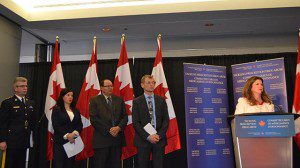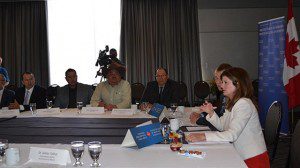(Chief Charles Weaselhead speaking in Edmonton. Photo APTN/Brandi Morin)
Brandi Morin
APTN National News
EDMONTON –The chief of an Alberta First Nation said his community is struggling to find solutions to a soaring prescription medication problem.
Chief Charles Weaselhead said after a meeting with Canada’s Health Minister Rona Ambrose this week that a lack of resources is holding the Blood Tribe back from getting people the attention they need.
Weaselhead, who attended a symposium in Edmonton that focused on prescription medication, said in the last six months there have been 40 overdoses and 20 deaths related to the use of Fentanyl, a potent and dangerous drug disguised as Oxy80s.
He said they are struggling to find access to proper treatment beds and detox facilities for community members.
“That in itself compounds the issue of people who are ready to go to treatment and it’s not there,” he said.
Ambrose met with various stakeholders to discuss ways of tackling the issue. She said the improper and recreational use of prescription drugs is threatening the health and safety of communities across the country.
“Substance abuse and prescription drug abuse are very serious and complex health, social and economic issues and as such cannot be addressed or resolved in isolation,” said Ambrose.
The federal government will fund $13 million over the next five years to undertake 1,000 annual pharmacy inspections across Canada.

The initiative is to help curb the increasing use of highly addictive pain prescription medications that are sold illegally on the streets.
According to a 2013 international products control survey, Canada is now the second largest per capita consumer of prescription opiates.
The 2012 Canadian Alcohol and drug use monitoring survey indicated that close to 1 million youth reported having used prescription drugs in the last 12 months. A large number of youth reported accessing prescription drugs at home in their own medicine cabinets.
Weaselhead said what his community needs are resources to help people.
“We do have a big problem and if we don’t find those beds, if we don’t find detox for them I’m afraid they’re going to go back to their habits. And we’ll continue to see over doses, we’ll continue to see the deaths and the number will continue to climb.”
Alberta Health Services (AHS) have been working closely with the Blood tribe and First Nations/Inuit Health Services.
AHS medical health officer of health for southern Alberta, Dr. Karen Goodison said while accessing resources is a challenge, addressing the situation is considered a top priority.
The AHS currently distributes a take home Naloxone Kit that serves as an anti-dote for reviving individuals who are overdosing.
“We will continue to build capacity for our community support and wrap around services, this needs to be a collective approach,” said Weaselhead.

Weaselhead said that Blood tribe officials continue to work to provide information to members focused on intervention and treatment for prescription drug abuse.
In April, Health Canada announced it will invest $13.5 million dollars over the next five years to First Nations communities across the country to enhance prevention and treatment capacity specifically for prescription drug abuse.
This will include crisis intervention teams that provide First Nation communities with counseling and other supports.
In addition Health Canada launched national TV ad campaigns to help equip parents with information on how to talk to teenagers about prescription drug use.
They also urge all Canadians to take their unused medications back to their local pharmacy when they’re no longer needed.










